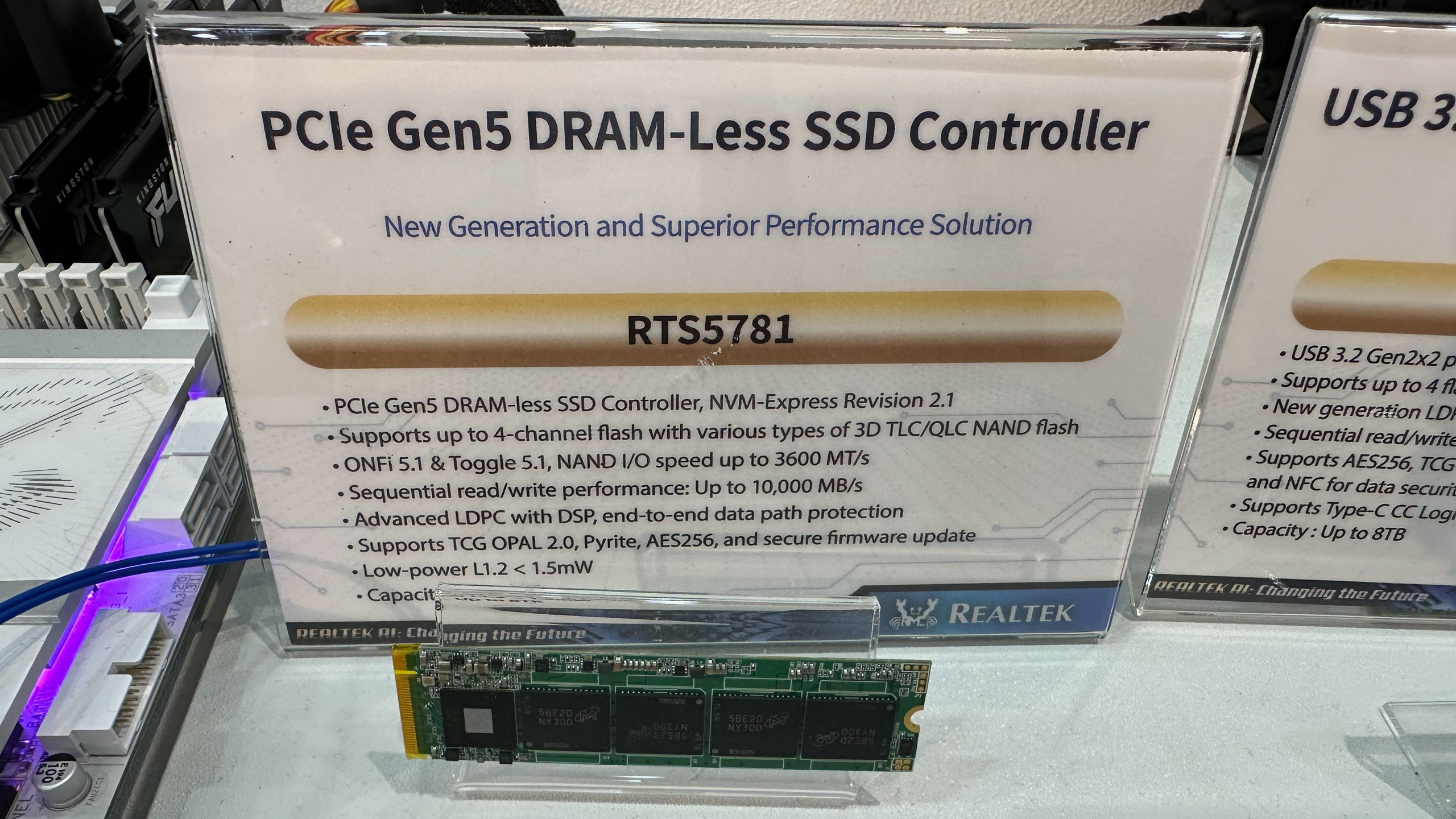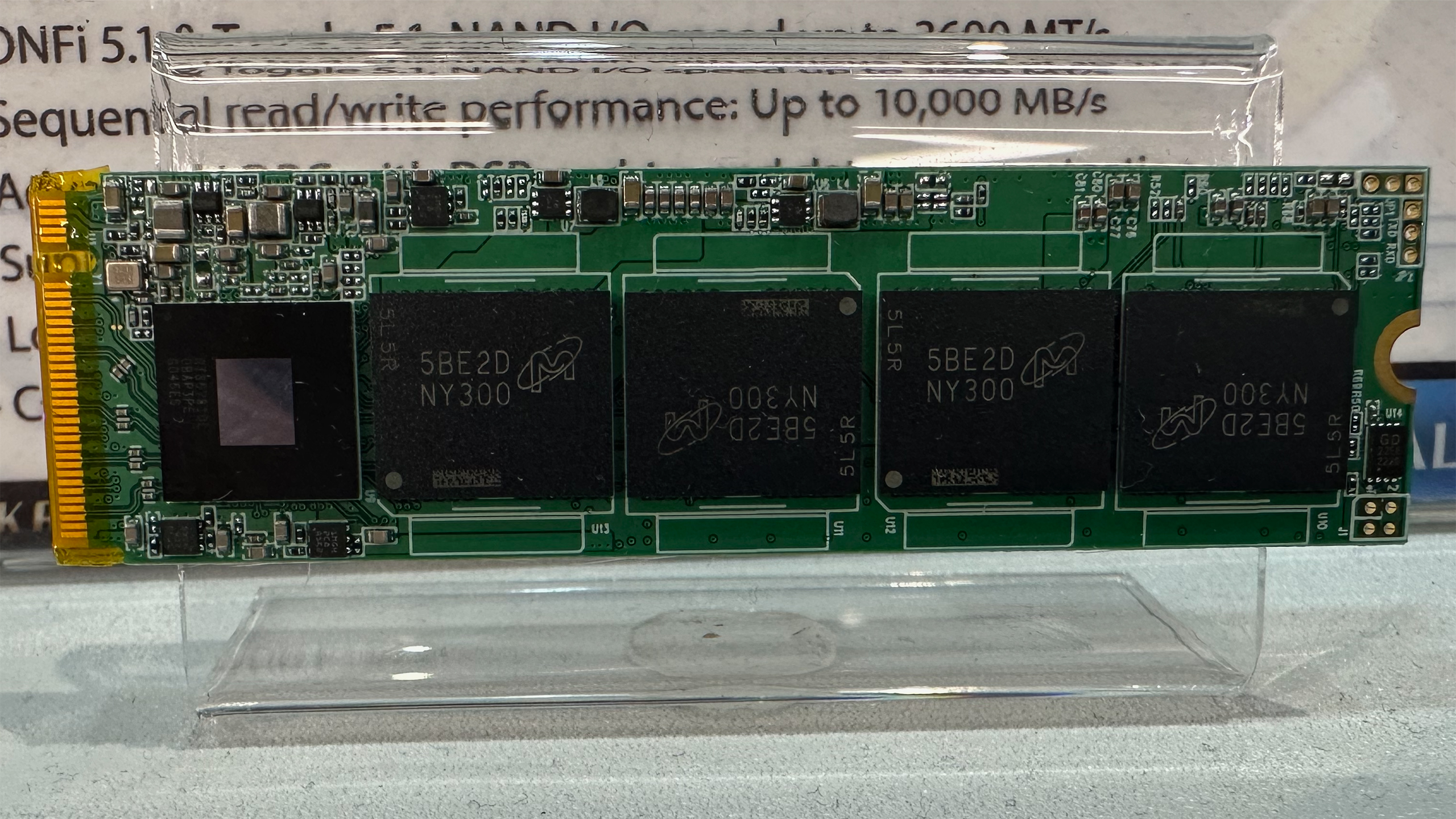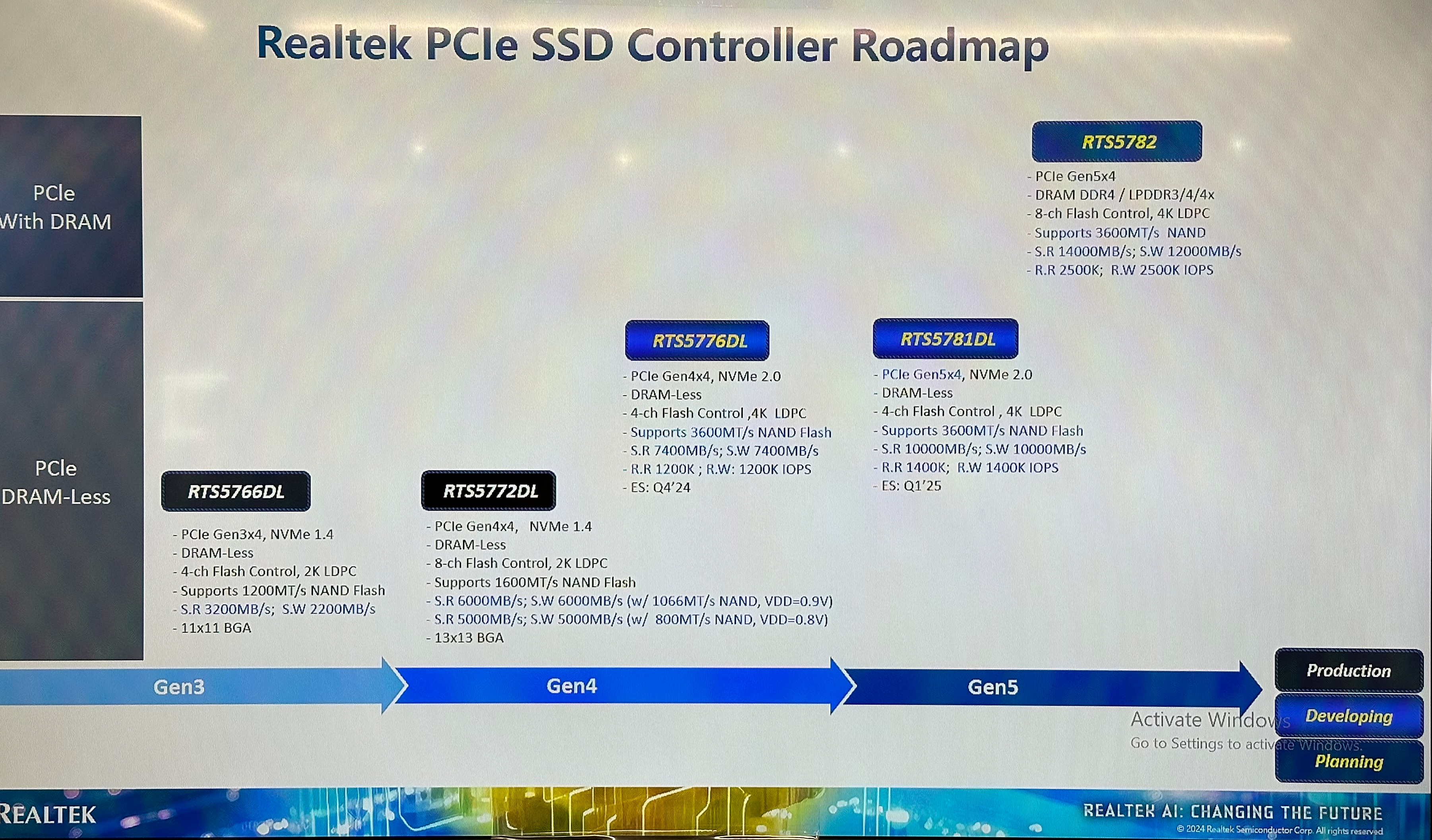Realtek eyes SSDs with new PCIe 5.0 x4 DRAM-less controller — Up to 10 GB/s and 1.4M IOPS
Realtek's RTS5781DL PCIe 5.0 controller will deliver sequential reads/writes up to 10,000 MB/s

Realtek is typically associated with audio, multimedia, and networking controllers for budget PCs, but for several years, the company has been trying to enter the SSD controller market, challenging established players. At this year's Computex, Realtek announced that samples of its RTS5781DL controller with a PCIe 5.0 x4 interface are now shipping to interested parties, so expect actual drives within the next year.
The Realtek RTS5781 is an NVMe 2.0-compliant DRAM-less SSD controller with a PCIe 5.0 x4 host interface designed for mainstream drives. The chip features four NAND channels supporting data transfer rates of 3600 MT/s and supports 4K LDPC error correction to ensure compatibility with contemporary 3D TLC and 3D QLC NAND memory devices. The controller can deliver sequential read and write speeds of up to 10,000 MB/s, with random read and write performance rated at 1.4 million IOPS each. The controller fully supports TCG OPAL 2.0, Pyrite, and AES256 encryption to enable makers of actual drives to address applications with high-security concerns.
Considering the typical development cycle of SSDs, we would not expect products based on the RTS5781 chip to hit the market until well into the second half of 2026, yet the company optimistically expects them to arrive in the second quarter of next year.
Last year, Realtek also revealed its ambitions for the premium SSD market with the RTS5782, its first controller designed with on-board DRAM support. This model will feature eight NAND channels supporting 3600 MT/s transfer rates, offering significantly improved throughput and efficiency compared to its RTS5781 DRAM-less counterpart.
Projected performance for the RTS5782 is aggressive. Drives built with this controller are expected to deliver sequential read speeds of up to 14 GB/s and sequential writes peaking at 12 GB/s. In terms of random I/O, the target is set at 2.5 million IOPS for both read and write operations, a substantial increase over the DRAM-less version and in line with what some of the best PCIe Gen5 SSDs offer today.
However, the status of the RTS5782 remains unknown as this year the company did not disclose its SSD controller roadmap. While Realtek has outlined the RTS5782's specifications and goals, the controller has yet to be developed, validated internally, reach prototyping and sampling stages, and then get approved by actual SSD makers. That said, expect the RTS5782 to arrive on the market considerably later than the RTS5781.
Follow Tom's Hardware on Google News to get our up-to-date news, analysis, and reviews in your feeds. Make sure to click the Follow button.
Get Tom's Hardware's best news and in-depth reviews, straight to your inbox.

Anton Shilov is a contributing writer at Tom’s Hardware. Over the past couple of decades, he has covered everything from CPUs and GPUs to supercomputers and from modern process technologies and latest fab tools to high-tech industry trends.
-
Pierce2623 only 4 channels and DRAMless but 10k r/w and 1.4m IOPS sound like a killer ass little $120 2TB drive…Reply -
Pierce2623 Reply
Huh? Integrating SSDs into the board sounds beyond stupid. Did the article mention that?palladin9479 said:Please no cheap integrated SSDs on motherboards. -
palladin9479 Reply
It's a joke on realtek. They are the ones who produce all the cheap integrated audio, network and wifi chips for motherboards.Pierce2623 said:Huh? Integrating SSDs into the board sounds beyond stupid. Did the article mention that? -
Notton Realtek also makes bridge chips.Reply
RTL9210 series is the defacto standard for a cheap m.2 NVMe/SATA to USB bridge chip. -
Pierce2623 Reply
Wait…you realize Realtek audio is normally decent quality these days, right? Or are you a “DAC until I die” type?palladin9479 said:It's a joke on realtek. They are the ones who produce all the cheap integrated audio, network and wifi chips for motherboards. -
palladin9479 ReplyPierce2623 said:Wait…you realize Realtek audio is normally decent quality these days, right? Or are you a “DAC until I die” type?
As I said, it was a joke because Realtek has a history of cheap and barely functional stuff, and we all clown on them for it. Also every sound solution has to have a Digital to Analogue Converter (DAC), you can't hear binary and so something has to be responsible for converting that binary steam to the analogue signal your speakers use to move sound cones. The quality of the DAC really matters, especially when it comes to shielding the audio line outs from ambient EMF that distorts the outgoing signal. Realtek has a deserved reputation for making cheap poorly shielded DAC's that use software for it's Digital Signal Processing (DSP), aka CODECs. They cleaned up much of that reputation over the years and current integrated DAC's aren't nearly as bad as they used to be, still there is only so much you can do when the DAC and analogue out traces are exposed to the EMF created by a processor running at 3~5Ghz a couple of inches away and a GPU pumping out even more a few inches the other way. It works for most people though because they just plug in cheap headsets or speakers, or are just bypassing the entire thing by using a USB dongle or BT wireless headset that has it's own DAC.
And because you were so insistent about it, I have my own personal story involving Realtek audio, ASUS motherboards and Windows 10. In my previous build I had an ASUS TUF Gaming H670-Pro Wifi D4, this includes a Reaktek audio CODEC.
https://www.asus.com/us/motherboards-components/motherboards/tuf-gaming/tuf-gaming-h670-pro-wifi-d4/
All was well until one day my games would randomly crash. Sometimes they would be fine for hours, other times it would just crash out. Months of pulling my hair out, reinstalling graphics drivers and messing around but it remained completely random. Until one day, on a whim, I reinstalled the audio drivers from ASUS (just to be sure) and no more random crash's. At least that's what I thought, then a few months later they all came back. I checked and the audio driver version was different, turns out Windows would "update" the older Realtek driver that ASUS provided and replace it with a newer one from Microsoft WHQL provided by Realtek. My MB wasn't compatible with that one and thus the source of all the random crash's. If I replaced it with my ASUS driver, it would only work until the next big feature update or patch bundle, then MS would replace it with the "newer" version. Instead I just disabled the MB audio and installed a PCIe sound card from Creative.
https://us.creative.com/p/sound-blaster/sound-blaster-z-sehttps://www.amazon.com/Creative-Internal-Headphones-Discrete-Supports/dp/B08HYPH5T6?th=1
$100 USD for an objectively better sound card that I can move from one system to another and whose manufacturer maintains support.
Also not all PCIe sound cards are created equal, here is a "cheap" $50 one made by creative but that has a Realtek ALC1220 DAC on it. Creative put their own CA0113-4AG DSP so it is still a hardware solution instead of relying on software CODECs, but there is only so much you can do with cheaper DAC's.
https://www.amazon.com/Creative-Upgradable-Internal-Discrete-SmartComms/dp/B09CQ4KRR1
The Z-SE is using a SoundCore3D™ (CA0113-4AG DSP) + CS4398 DAC. The CS4398 is an older but very well respected and solid DAC. Those two cards both use the exact same DSP to process the audio but very different DAC's to convert the signal into audio for you to hear. Also the Z-SE use's a shielded cage around the DSP's in an attempt to reduce the ambient EMF interference.
Then we have the AE-5 (and it's brother 7) which are probably some of the best PCIe sound cards you are going to get.
https://www.amazon.com/Creative-BlasterX-SABRE32-class-Discrete-Headphone/dp/B086QN3WNX
That is using the same CA0113-4AG DSP but this time with an ESS SABRE32 DAC which is really good but more also more expensive. There are two internal amps, one for the left channels and one for the right channels, as a way to reduce L/R cross talk. Even better EMF shielding (no window) then the Z-SE. It's also 32-bit native on the DAC meaning Windows Direct Audio samples don't have to be down sampled. Direct Audio is a way for you to send audio data straight from a game into the sound card without any mixing or modification at the OS level, those samples are natively 32-bit.
Anything more then that requires an external unit which is really for Audiophiles. My point is that a good PCIe sound card is definitely a step up from any unshielded onboard DAC + software DSP solution. Realtek makes products that are "good enough" but not of particularly high quality.. Their GBIC's, Wifi chips and audio DACs and everywhere on consumer devices but absent in the higher tier professional spaces. Think of them as the Fast Food of computer components. And since practically every product they make ends up as a MB integrated solution due to low cost, the joke is that their new SSD line will ultimately end up as one too. -
mrdoc22 I prefer "RealTek Nic" over "Intel Nic"Reply
(I have both, have more problems with "Intel Nic"),
and RealTek is updating they drivers alot more than Intel

